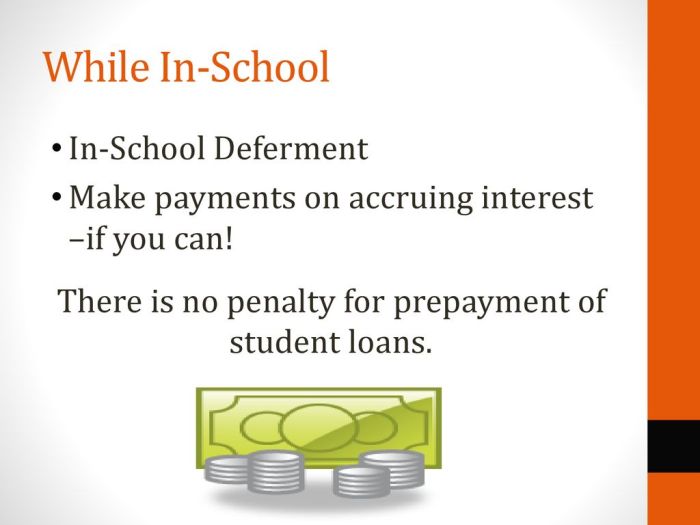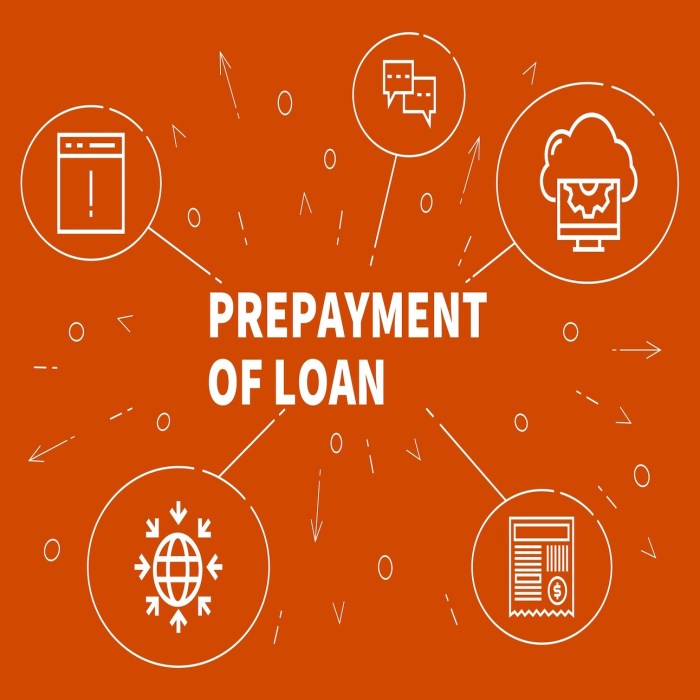
Navigating the complex world of student loan repayment can feel overwhelming, especially when considering the possibility of prepaying your debt. The question of whether prepayment penalties exist is a crucial one, impacting your financial strategy and long-term savings. Understanding the nuances of federal versus private loans, and the potential benefits and drawbacks of early repayment, is essential for making informed decisions about your financial future.
This exploration delves into the specifics of prepayment penalties for both federal and private student loans. We’ll examine government policies, lender practices, and the various factors you should weigh before deciding whether to prepay. By the end, you’ll have a clearer understanding of how prepayment could impact your credit, overall financial health, and long-term financial goals.
Federal Student Loan Prepayment Penalties

The good news for borrowers is that the federal government does not impose prepayment penalties on federal student loans. This means you can pay off your loans early without incurring any extra fees or charges. This policy applies consistently across various federal student loan programs, offering flexibility to borrowers who wish to accelerate their repayment.
Federal Student Loan Prepayment Penalty Policy
The official government policy regarding prepayment penalties for federal student loans is explicitly stated: there are none. This applies to all federal student loan programs, including Direct Subsidized Loans, Direct Unsubsidized Loans, Direct PLUS Loans (for parents and graduate students), and Federal Perkins Loans (though these are less common now). This consistent lack of penalties provides borrowers with the freedom to manage their debt in a way that best suits their financial circumstances. This is a significant benefit compared to some private loans which may include prepayment penalties.
Advantages and Disadvantages of Prepaying Federal Student Loans
Prepaying federal student loans can be advantageous in several situations. For example, if you receive a large sum of money (inheritance, bonus, etc.), you can significantly reduce the total interest paid over the life of the loan, saving considerable money in the long run. Also, eliminating student loan debt can reduce overall financial stress and improve credit scores more quickly. However, prepayment might be disadvantageous if you have other high-interest debts (such as credit card debt) that could benefit from more aggressive repayment strategies. It’s crucial to prioritize paying down high-interest debt first before focusing on lower-interest federal student loans. Another potential disadvantage is the loss of access to the funds, which could be used for other investments or emergencies.
Comparison of Federal Student Loan Repayment Plans and Prepayment Implications
The choice of repayment plan doesn’t affect the absence of prepayment penalties, but it does impact the amount you pay overall and how quickly you can pay off your loan. Different plans have different minimum monthly payments and repayment timelines. Paying more than the minimum payment, regardless of the plan, will reduce the total interest paid.
| Repayment Plan | Monthly Payment | Repayment Time | Prepayment Impact |
|---|---|---|---|
| Standard Repayment | Fixed, based on loan amount and interest rate | 10 years | Prepaying reduces principal, lowering total interest paid and shortening repayment time. |
| Graduated Repayment | Starts low, increases over time | 10 years | Prepaying can significantly reduce the amount of later, higher payments. |
| Extended Repayment | Lower monthly payments | Up to 25 years | While payments are lower, prepaying is advantageous to reduce the total interest paid over the longer repayment period. |
| Income-Driven Repayment (IDR) | Based on income and family size | 20-25 years | Prepayment can significantly shorten the repayment period and reduce total interest paid, potentially leading to loan forgiveness sooner under some IDR plans. |
Private Student Loan Prepayment Penalties
Unlike federal student loans, private student loans frequently include prepayment penalties. These penalties can significantly impact borrowers who unexpectedly receive funds or refinance their loans, making it crucial to understand the terms before signing a loan agreement. This section details common practices, examples, and comparisons of prepayment penalty policies among major private student loan providers.
Prevalence of Prepayment Penalties in Private Student Loan Agreements
Private lenders, unlike the federal government, are businesses aiming for profit maximization. As such, they may include prepayment penalties in their loan agreements to compensate for lost future interest income. These penalties are typically expressed as a percentage of the principal amount prepaid or a fixed dollar amount, and their inclusion is often explicitly stated within the loan documents. The exact terms vary considerably depending on the lender, the specific loan product, and the prevailing market conditions at the time the loan was originated. Borrowers should meticulously review the loan agreement before signing to understand any potential prepayment penalties.
Examples of Prepayment Penalty Clauses in Loan Agreements
Consider two hypothetical examples. Loan Agreement A from Lender X might state: “Prepayment Penalty: A prepayment penalty of 3% of the principal balance will be assessed if the loan is paid in full within the first five years.” Conversely, Loan Agreement B from Lender Y could stipulate: “Prepayment Penalty: No prepayment penalty applies to this loan.” These illustrate the stark contrast that can exist between different private lenders. Real-world examples would similarly vary, with some lenders using percentage-based penalties, others using fixed-dollar amounts, and still others imposing no penalty at all. The specific wording and calculation methods are key details that borrowers need to understand.
Comparison of Prepayment Penalty Policies Across Three Major Private Lenders
Let’s compare hypothetical prepayment penalty policies of three major (fictitious) private student loan providers: Lender X, Lender Y, and Lender Z. Lender X might charge a 2% penalty on prepayments within the first three years, declining to 1% in years four and five, and then no penalty thereafter. Lender Y might have a flat $500 prepayment penalty regardless of the amount prepaid or the time elapsed. Lender Z, in contrast, might have no prepayment penalty for any loan. These represent potential scenarios; the actual policies of real lenders will need to be checked directly on their websites or in their loan documents.
Hypothetical Loan Agreement Snippets: With and Without Prepayment Penalty
Scenario 1: With Prepayment Penalty
Prepayment Penalty: A prepayment penalty equal to 1% of the outstanding principal balance will be applied if the loan is paid in full before the maturity date. This penalty will be deducted from the prepayment amount.
Scenario 2: Without Prepayment Penalty
Prepayment: Borrower may prepay all or any portion of the principal balance at any time without penalty.
These snippets highlight the critical difference a prepayment penalty clause can make to the borrower’s overall loan cost. The absence of a prepayment penalty provides greater flexibility and potentially significant savings for borrowers who can afford to repay their loan early.
Factors Influencing Prepayment Decisions

Prepaying student loans can be a strategic move, but it’s crucial to carefully weigh the financial implications before making a decision. Several key factors interact to determine whether prepayment is beneficial in your specific circumstances. Understanding these factors will empower you to make an informed choice aligned with your long-term financial goals.
Prepayment of student loans involves a trade-off between reducing long-term interest costs and maintaining financial flexibility for other important goals. The decision hinges on a careful assessment of current financial resources, future financial projections, and the prevailing interest rates on your loans. Failing to consider these factors could lead to unnecessary financial strain or missed opportunities.
Financial Factors to Consider Before Prepaying
Before deciding to prepay student loans, individuals should carefully analyze their current financial standing and future prospects. This includes evaluating their emergency fund, ongoing expenses, and other debt obligations. High-interest debt, such as credit card debt, should generally be prioritized over prepaying student loans with lower interest rates. Furthermore, it’s essential to consider future financial goals, such as saving for a down payment on a house, investing in retirement, or funding higher education for children. Prepaying student loans might delay the achievement of these important milestones.
Benefits and Drawbacks of Prepaying Student Loans
Prepaying student loans offers the clear benefit of reducing the total interest paid over the life of the loan. This can translate into significant savings, especially for loans with high interest rates. However, prepaying also carries potential drawbacks. The primary drawback is the loss of access to those funds for other potentially lucrative investment opportunities. For instance, investing the money pre-allocated for loan prepayment might yield a higher return than the interest saved on the loan. This needs careful consideration, especially in a period of high inflation and rising interest rates. For example, if you could earn a 7% return on investments while your student loan interest rate is 5%, it might be more financially advantageous to invest the money rather than prepay.
Step-by-Step Guide for Evaluating Prepayment
A structured approach to evaluating student loan prepayment ensures a well-informed decision.
- Assess your current financial situation: Calculate your monthly income, expenses, and existing debt. Determine how much disposable income you have after meeting essential needs and debt obligations.
- Evaluate your emergency fund: Ensure you have at least three to six months’ worth of living expenses saved in an easily accessible account. Prepaying loans should not compromise your financial safety net.
- Analyze your student loan details: Identify the interest rates, loan balances, and repayment terms for each loan. Prioritize loans with the highest interest rates for prepayment.
- Consider alternative investment opportunities: Research potential investment options, such as high-yield savings accounts, index funds, or bonds. Compare the potential returns to the interest rate on your student loans.
- Project your future financial goals: Consider major upcoming expenses, such as a down payment on a house, wedding, or children’s education. Determine if prepaying student loans would significantly hinder these goals.
- Make a decision: Based on your analysis, determine if prepaying student loans aligns with your overall financial goals and risk tolerance. If the potential return on alternative investments exceeds your student loan interest rate, it may be wiser to invest the money instead.
Resources for Informed Decision-Making
Making informed decisions regarding student loan prepayment requires access to reliable information and tools.
- Your loan servicer: Contact your loan servicer to obtain detailed information about your loans, including interest rates, repayment schedules, and prepayment options.
- Financial advisor: A qualified financial advisor can provide personalized guidance based on your individual circumstances and financial goals.
- Online financial calculators: Numerous online calculators can help you estimate the potential savings from prepaying student loans and compare the returns of different investment options.
- Government websites: Websites like StudentAid.gov (for federal loans in the US) provide valuable information on student loan repayment and management.
Consequences of Prepayment
Prepaying student loans can have significant consequences, both positive and negative, impacting your credit score, overall financial health, and long-term financial planning. While the immediate gratification of reducing debt is appealing, a thorough assessment of your financial situation is crucial before making a decision. It’s not always the best financial move, despite the seeming advantage of paying off debt faster.
Prepayment’s Impact on Credit Score and Financial Health
Impact on Credit Score
Prepaying student loans generally doesn’t directly boost your credit score. Credit scoring models primarily consider factors like payment history, credit utilization, and the length of your credit history. While a lower debt-to-income ratio (DTI) resulting from prepayment might indirectly improve your score over time, it’s not a guaranteed outcome. The positive impact is often marginal and dependent on other factors already present in your credit report. Focusing on consistent on-time payments across all your accounts is far more impactful for your credit score than aggressively prepaying student loans.
Impact on Overall Financial Health and Long-Term Financial Planning
Prepaying student loans ties up funds that could be used for other potentially higher-return financial goals. This includes investing in retirement accounts (like 401(k)s or IRAs), building an emergency fund, or investing in other assets that could generate higher returns than the interest rate on your student loans. For example, if you have high-interest debt, such as credit card debt, it’s generally more financially prudent to pay that down first before prepaying your student loans, which often carry lower interest rates. By focusing on higher-interest debts first, you save more money in the long run. Diversifying your financial strategy and allocating resources strategically across different financial goals is key to long-term financial success.
Situations Where Prepaying Might Be Financially Unwise
Several scenarios illustrate when prepaying student loans is not the optimal financial strategy. If you have high-interest debt, prioritizing its repayment yields greater savings than prepaying lower-interest student loans. Similarly, if you lack an emergency fund, building one should take precedence. Unexpected expenses can derail your financial progress, making an emergency fund a crucial safety net. Investing in opportunities with higher potential returns than your student loan interest rate, such as a well-diversified investment portfolio, can lead to greater wealth accumulation over time. For instance, consistently investing in a low-cost index fund could potentially yield significantly higher returns than the interest saved by prepaying student loans.
Long-Term Financial Implications of Prepayment vs. Investing
Let’s consider a hypothetical scenario: Suppose you have $10,000 available to prepay your student loans, which have a 5% interest rate. Alternatively, you could invest that same $10,000 in a diversified portfolio with an average annual return of 7%. Over 10 years, prepaying the loan saves you approximately $1,250 in interest. However, investing the $10,000 could potentially grow to approximately $19,670, resulting in a much greater financial gain. This example highlights the potential long-term benefits of investing versus prepaying, particularly if the investment’s return exceeds the interest rate on the loan. The decision hinges on the potential returns of alternative investments compared to the interest rate on the student loan. The difference in these rates can dramatically affect the outcome.
Understanding Loan Agreements
Before signing any student loan agreement, meticulously reviewing the terms and conditions is paramount. Failing to do so could lead to unforeseen financial burdens, particularly concerning prepayment penalties. Understanding the specifics of your loan agreement empowers you to make informed decisions about repayment strategies.
Understanding the intricacies of a student loan agreement is crucial for avoiding unexpected costs. These agreements often contain legal jargon that can be difficult to decipher. However, taking the time to thoroughly read and comprehend the document can save you significant money in the long run. Specifically, focusing on clauses related to prepayment is essential to determine whether early repayment will incur additional fees.
Prepayment Penalty Clauses in Loan Agreements
Prepayment penalty clauses, if present, will explicitly state any fees associated with paying off your loan early. These clauses typically Artikel the calculation method for the penalty, which might be a fixed percentage of the outstanding loan balance or a specific dollar amount. The location of these clauses varies depending on the lender and the type of loan; however, they are frequently found within sections detailing repayment terms, fees, or default provisions. Careful examination of these sections is critical to identifying the presence and nature of any prepayment penalties.
Interpreting Legal Language in Student Loan Documents
Many student loan agreements utilize complex legal terminology. To effectively interpret these documents, consider utilizing resources such as online dictionaries of legal terms or seeking assistance from a financial advisor or legal professional. Breaking down complex sentences into simpler components can also aid comprehension. Focus on identifying key phrases like “prepayment penalty,” “early repayment,” “interest calculation,” and “default.” Understanding these terms within the context of the entire agreement will provide a clearer picture of your rights and responsibilities.
Visual Representation of Key Sections in a Student Loan Agreement
Imagine a document divided into sections. The top section contains general information, such as borrower details and loan amount. A subsequent section, often labeled “Repayment Terms,” would detail the repayment schedule, including the monthly payment amount, interest rate, and loan duration. Crucially, within this section, or a closely related section titled “Fees and Charges,” a subsection would address prepayment penalties. This subsection would clearly state whether a penalty exists, how it’s calculated (percentage or fixed amount), and under what conditions it applies. A further section, possibly labeled “Default,” would Artikel the consequences of failing to make timely payments, which might include additional fees. Finally, a signature section would confirm the borrower’s understanding and acceptance of all terms.
Last Point

Ultimately, the decision of whether or not to prepay your student loans is a personal one, deeply intertwined with your individual financial circumstances and long-term objectives. While federal loans generally offer penalty-free prepayment, private loans may carry associated costs. Carefully reviewing your loan agreements, considering the potential benefits and drawbacks, and consulting with a financial advisor can empower you to make the most financially sound decision for your unique situation. Remember, proactive financial planning is key to achieving long-term financial success.
FAQ Summary
What happens to my interest if I prepay my federal student loans?
Prepaying your federal student loans will reduce the principal balance, lowering the amount of interest that accrues over time. You’ll save on interest payments in the long run.
Can I prepay part of my student loan?
Yes, you can typically make extra payments on your student loans at any time without penalty (for federal loans). Even small extra payments can make a significant difference over time.
How does prepaying affect my credit score?
Prepaying student loans doesn’t directly impact your credit score negatively. However, consistently making on-time payments, including early payments, demonstrates responsible financial behavior, which can positively influence your credit score over time.
Should I prepay my student loans or invest the money instead?
This depends on your individual financial situation and risk tolerance. If your student loan interest rate is significantly higher than your potential investment returns, prepaying might be advantageous. Consult a financial advisor for personalized guidance.
